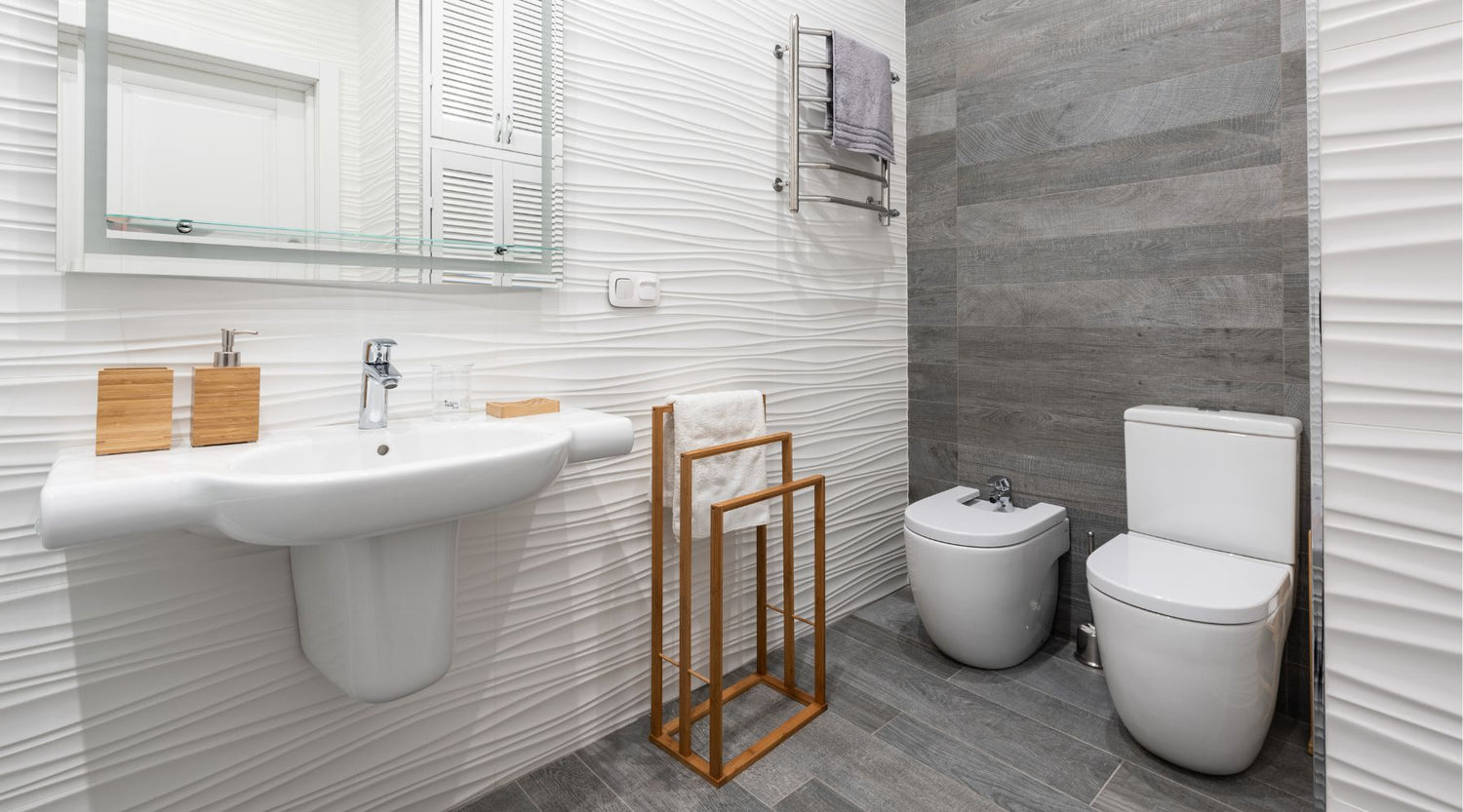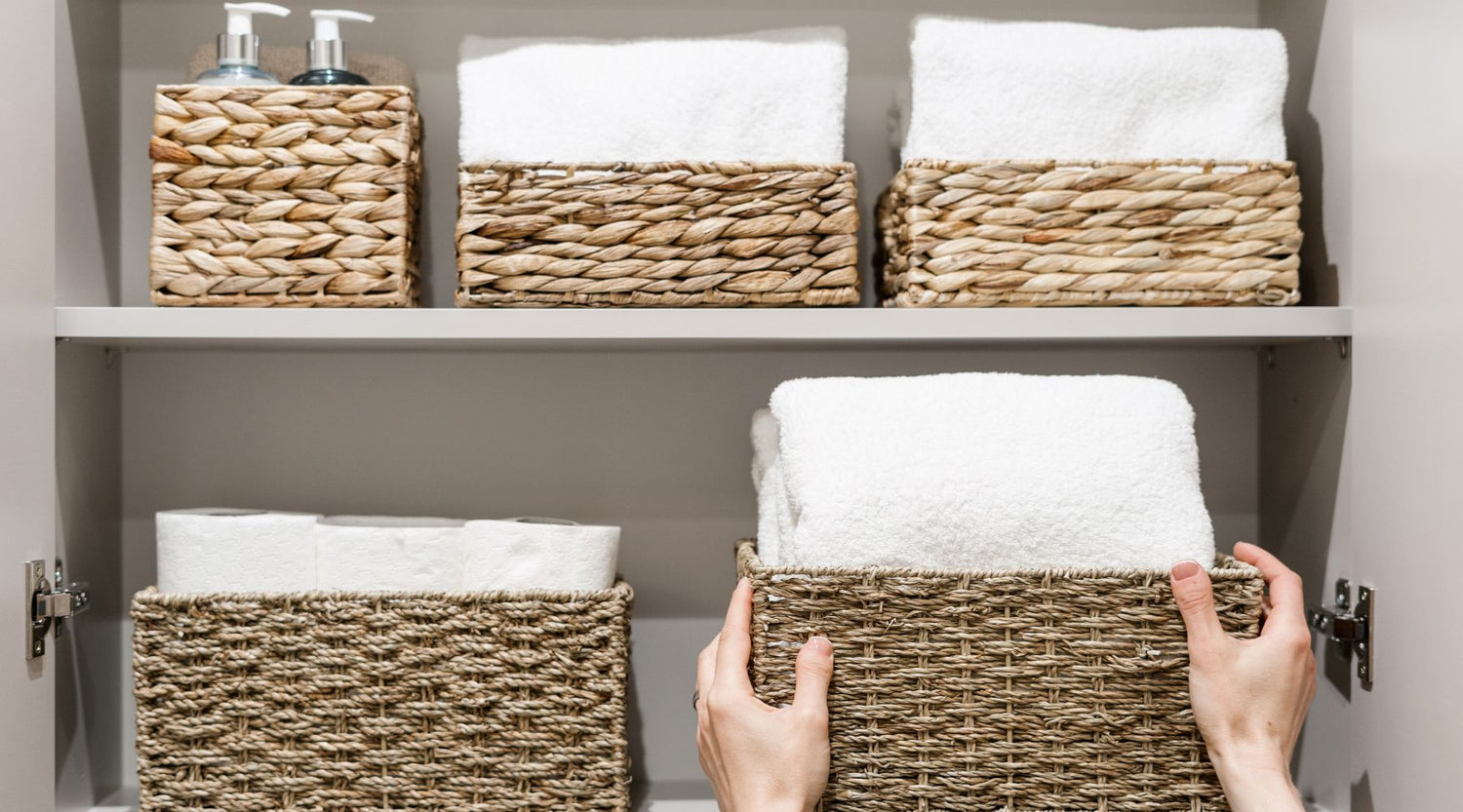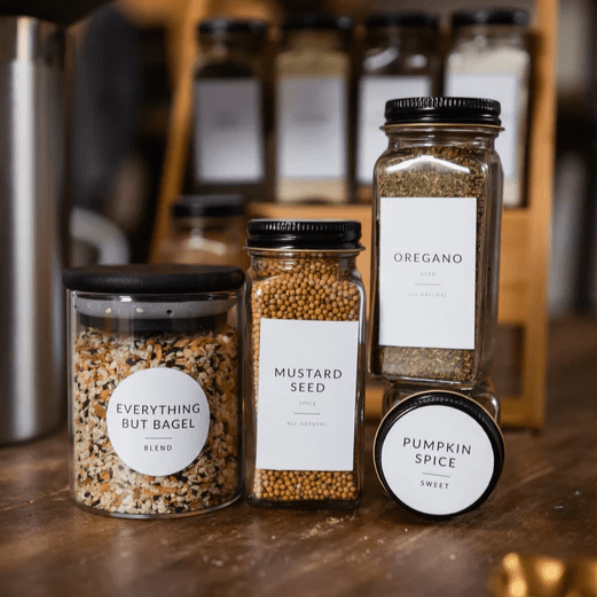A spacious pantry with deep shelves is great, but it can be tricky to keep organized.
Quick links:
You can easily lose track of what you have, leading to time-consuming searching, food waste, and unnecessary spending.
The answer is a well-organized pantry. Our pantry labels and storage solutions will help with that.
Clean shelves and take inventory
Before you start organizing, take everything out of your pantry. Clean all the shelves and vacuum up crumbs, dust, and debris.
Take inventory of everything you have. Make a list. Use pen and paper—or a spreadsheet if you’re inclined. Have pantry items sorted alphabetically if possible.
Next, narrow down the broad categories. For example, group food items like this:
- Drinks
- Snacks
- Bread
- Canned food
- Breakfast items
- Dry goods
- Baking supplies
As you catalog items, you can also do the following:
- Get rid of expired items.
- If you have more than you need, give excess food away. A friend in need or a food bank will appreciate your efforts.
Divide into zones
Before you restock your pantry, divide the space into zones that best serve your household’s needs.
Here’s one way to divide your pantry into zones:
- Zone 1. All cooking items, such as canned foods, spices, baking and cooking supplies, and dry goods, can be at eye level. Everything needs to be quick and easy to access while you are cooking.
- Zone 2. Breakfast food and bread can be placed on the lower left shelves. This way, kids can reach these items.
- Zone 3. Snacks can go on the lower right shelves. Whenever kids want to get chocolate chips, granola bars, or other snacks, they can easily help themselves.
- Zone 4. Heavy items can be placed on the floor.
- Zone 5. Bulk drinks and seasonal items can be put on the upper shelves since they are not used often.
This simple yet effective system can maximize your storage space and organize your pantry.
Use storage containers
The right storage containers help you organize your deep pantry shelves. You can neatly stack items and use up all of your space while still being able to see everything.
Look for containers that are clear. Square and rectangular pantry containers will typically maximize space better than round ones.
Some good options include:
- Plastic storage bins. Choose bins with lids in a variety of sizes to hold everything from pasta and rice to snacks. Stack them on shelves or place them on turntables for easy access.
- Can organizers. Keep canned goods tidy by placing them in wire racks designed specifically for cans. These tend to be about 12 inches deep—perfect for deep shelves.
- Spice organizers. Use sectioned acrylic organizers to neatly arrange spices and seasoning packets. Transparency makes it simple to identify what you need.
- Cereal containers. Large containers with lids keep cereal fresh while allowing you to easily pour out a bowlful at a time.
Install pull-out drawers
Another space-saving solution is to install pull-out drawers in your pantry. This allows you to neatly organize everything while still being able to access items at the back.
Mounted on tracks, the drawers glide smoothly in and out of the pantry. You can find ready-made drawer sets for pantries in various sizes. Alternatively, you can consider having custom drawers built to fit your shelves perfectly.
Pull-out drawers are great for storing smaller items that can otherwise get lost at the back of deep shelves:
- Condiments such as sauces and salad dressings
- Seasoning packets and baking ingredients
- Cans of vegetables, fruits, and beans
- Snack items like granola bars
If installing permanent drawers is not an option, consider using temporary slide-out trays or baskets to create a similar effect.
Use a Lazy Susan
A Lazy Susan is a great organizing tool for corner cabinets and deep pantry shelves. This round turntable allows you to easily see everything you have stored by rotating the rack in a stationary position.
Lazy Susans are ideal for corner spaces that tend to turn into black holes. Spinning the tray lets you neatly arrange items in a circular pattern. Things stay visible and accessible instead of disappearing into the void.
Use one to store round containers like jars of sauces and condiments, or keep baking mixes handy for quick access when cooking. This organization tip makes it simple to see and grab whatever you need from even the deepest parts of the pantry.
Use pantry doors
Pantry doors offer extra storage potential that often goes overlooked. Integrate the pantry doors into your organization system to maximize space. Optimize vertical storage space by adding racks, bottle caddies, and towel bars to inner door surfaces.
Repurpose flat door panels into display space, and mount chalkboards for grocery shopping lists or magnetic panels to remind you when stocks run low.
With some clever planning, those built-in doors become invaluable organizational tools rather than unused space.
Use labels
A labeling system is a crucial part of maintaining organization in your deep pantry. Labels allow you and other household members to instantly identify items—especially those stored in containers.
Use a label maker or printable labels to mark everything in your pantry: shelves, bins, baskets, glass jars, boxes, containers, and more.
Masking tape and a marker can work but aren't quite as durable or aesthetically pleasing as our preprinted labels. Our minimalist white pantry label set comes with 176 preprinted labels that cover all the main food categories. 
Or, if you prefer black, try our black minimalist pre-printed label set.
Create a consistent labeling scheme with the following tips:
- Use all capital letters in a standard font for easy reading.
- Organize alphabetically or categorize by type of ingredient.
- Place labels on the front edge of shelves and the front center of containers.
- Label both the interior and exterior of door shelves so you can identify contents whether open or closed.
Check and update your labels periodically to be sure nothing gets mislabeled.
An organized pantry will stay that way with the help of a simple yet effective labeling system.
How to maximize deep shelves?

If you have particularly deep pantry shelves, it can be difficult to use all of your space effectively. With some clever storage solutions, you can maximize and transform those deep shelves and get the most out of your pantry space.
Try these hacks to do just that:
- Use shelf risers
- Add extra shelves
- Slope the shelves
Use shelf risers
One easy way to maximize deep pantry shelves is to use shelf risers. These sturdy platforms lift items closer to the front so you can see and reach items stored at the back.
Look for heavy-duty risers made of wood, metal, or thick plastic that can handle plenty of weight without sagging. Place one riser near the back to push items forward. For ultra-deep shelves, add another riser in front to lift things even closer.
Now you've created a tiered display space. Use the back tier for less-used items like seasonal baking ingredients and overflow stock. Keep everyday staples up front for grab-and-go convenience.
Add extra shelves
Another great solution is to install additional shelves to divide those intimidatingly deep spaces into more manageable sections.
Purchase ready-made extra shelves, or have some custom-cut shelving installed at regular intervals to segment your deep shelves into neat compartments.
This opens up more usable shelf space and prevents things from getting lost in the abyss. Tailor the shelf heights to your storage needs—keep everyday ingredients within arm's reach below while reserving harder-to-access upper shelves for overflow and rarely used items.
Slope the shelves
For a clever low-profile solution, slope your existing shelves to gently nudge contents forward. This subtle tilt makes the most of deep shelf space by sliding items into view.
Simply secure small wood blocks, furring strips, or other risers to the underside at the back edge of each shelf. Then remove and reposition the shelf brackets so the rear sits slightly higher than the front, creating an angled surface.
The slope allows gravity to lend a helping hand. Cans, boxes, and containers neatly align at the front of each tilted shelf and ingredients become easier to see.
Naturally, you don’t want items sliding off the shelves, so this hack will only work if your shelves have a small lip at the edge.
How to organize a narrow deep pantry?
A deep, narrow pantry can be optimized. With proper organization, even the narrowest spaces can be great for storing pantry items.
Here are some narrow deep pantry organization ideas:
- Install pull-out shelves. These allow you to see and access items towards the back. Full extension shelves let you pull them out and are perfect for deep yet narrow spaces.
- Use Lazy Susans or spinning racks. These rotating racks make items in corners more accessible.
- Use tiered racks or risers to create layers. You can stack items vertically to take advantage of tall but narrow sections.
- Use clear plastic bins to group similar items. Label the front of the bins so you know what's inside without having to pull them out.
- Install door racks on the inside of the pantry door to stash small items and free up shelf space.
- Use shelf dividers and vertical partitions to create compartments for different food categories.
- Make the most of prime real estate by keeping everyday-use items on middle shelves at eye level. Reserve top and bottom shelves for occasionally used and overflow items.
- Store less frequently used small appliances like mixers on the top shelf. Use the bottom shelf for heavier items, large bags of pet food, bulk drink items, etc.
- Maximize vertical storage space. Use wall-mounted spice racks, nested containers, and multi-level racks.
- Keep it minimal. Don't over-buy things just to fill the space. Only store what you use regularly.
Deep pantry FAQ
How can I make my deep pantry more useful?
To better utilize the space in a deep pantry, consider installing extra shelves or slide-out shelves to create more usable layers for storage. Also, use storage containers of different heights to maximize the use of vertical space. Deeper pantries require proper labeling so that items don't get lost in the back. Regularly purge expired or unwanted foods so prime real estate isn't taken up unnecessarily.
How do you store food in a deep cupboard?
The most effective way to store food in a deep cupboard is to use a combination of shelves and clear plastic stacking bins for dry goods. Place frequently-used items on easy-to-access shelves closer to the front, while less used items can go in bins on higher shelves.
Labels on the outside of bins keep contents visible. Also, use vertical pantry organizers or drawer inserts to neatly arrange smaller items.
How do you use space at the bottom of the pantry?
The bottom space of a pantry tends to be an underutilized area. Install a slide-out shelf to access items tucked far back more easily. Store bulky baking supplies or small appliances you only use occasionally in the bottom sections.
You can also use the lowest shelf for extra paper goods, cleaning supplies, or pet food storage since those things don't need to be readily displayed.
How do you organize snacks in a deep pantry?
The best way to organize snacks in a deep pantry is to keep healthy and indulgent snacks separate, with healthier options in clear containers upfront. Use stacking bins for chips, pretzels, crackers, and other crunchy snacks to maximize vertical space efficiency.
Install hooks on the backs of doors to hang portable bags of chips. You can also utilize an over-the-door shoe organizer for granola bars, squeeze pouches, and other grab-and-go snacks to make the best use of the space.
How do you organize deep narrow kitchen cupboards?
The best way to organize deep narrow kitchen cupboards is to use vertical space properly. Install pull-out drawer organizers to access items in the back more easily. Door-mounted racks and bins also add usable storage space without taking up floor space. Use turntables or tiered shelves to better see what's inside.
How to organize a deep walk-in pantry?
A deep walk-in pantry can be perfect for storing all your kitchen supplies, but it is important to maximize only if you get the best out of its potential. Here are some steps to you can follow:
- Conduct an inventory check in the pantry before creating a n organizational plan. Group like items together—paper products on one shelf, baking essentials on another, cereal boxes and grains in labeled pantry containers on another.
- Use shelf risers, adjustable drawers, and storage bins to effectively use the vertical storage potential. No more frustrating dead space in hard-to-access areas.
- Strategically place everyday staples on easy-to-reach shelves at eye level or in slide-out cabinets. Reserve upper levels and deep cabinetry for overflow stock and rarely used items.
- Label shelves all shelves clearly for easy identification of categories such as spices, canned vegetables, snack foods, etc.






